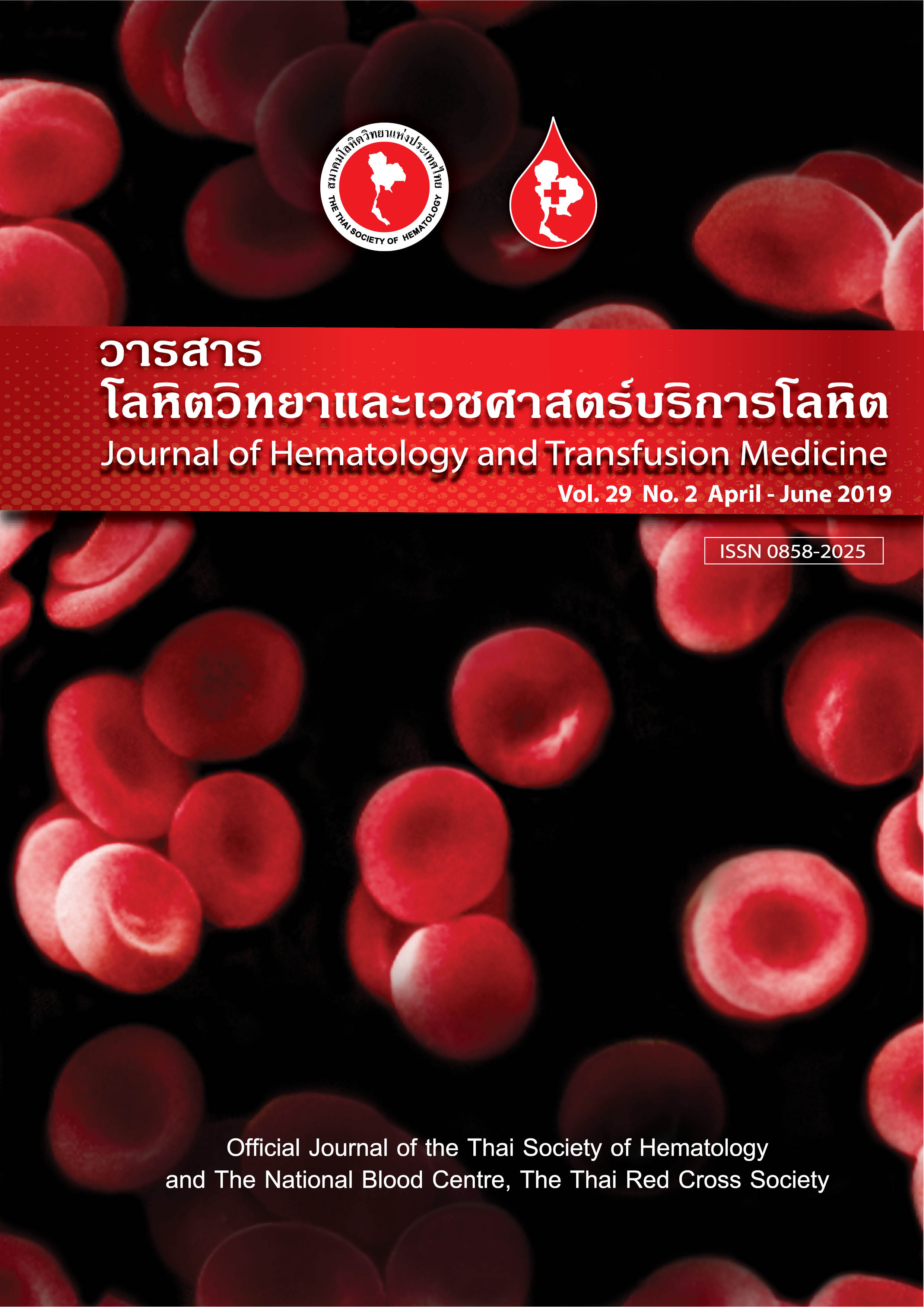AB para-Bombay phenotype with anti-H: a case report
คำสำคัญ:
พาราบอมเบย์, หมู่เลือดเอบีโอที่ไม่สอดคล้อง, แอนติเอช, Para-Bombay, ABO discrepancy, Anti-Hบทคัดย่อ
บทคัดย่อ
ผู้ป่วยหญิงอายุ 20 ปี อายุครรภ์ 17+5 สัปดาห์ มาฝากครรภ์ที่โรงพยาบาลศิริราช ผลการตรวจร่างกายและผลการตรวจเลือดทางห้องปฏิบัติการทั่วไปอยู่ในเกณฑ์ปกติ แต่เมื่อตรวจหาหมู่เลือดพบว่าเกิด ABO discrepancy ผล cell grouping เข้าได้กับหมู่เลือด O RhD positive แต่ผล serum grouping มีความแรงเพียง 2+ ทั้งกับ A1 cells และ B cells จึงทำการตรวจซ้ำโดยวิธี conventional tube test เพิ่มการตรวจด้วย anti-H และ incubate ที่อุณหภูมิห้องต่ออีก 30 นาที พบว่าเม็ดเลือดแดงของผู้ป่วยมี weak A antigen แต่ไม่มี H antigen ส่วนผล serum grouping ยังคงไม่สอดคล้องกับผล cell grouping ประกอบกับตรวจ antibody screening ให้ผลบวกทั้ง 3 screening cells จึงคาดว่ามี antibody อื่นมารบกวนทำให้แปลผลได้ยาก อาทิ ผู้ป่วยมี antibody ต่อ high incidence antigen เช่น anti-H เมื่อทำ adsorption and elution test และ saliva test เพิ่มเติม พบว่าเม็ดเลือดแดงของผู้ป่วย มี A antigen และ B antigen ในน้ำลายมี A B และ H antigen ส่วนผลของ antibody identification เกิด agglutination ทั้ง 11 cells ใน panel โดยมีความแรงของปฏิกิริยาเท่า ๆ กัน ที่อุณหภูมิห้อง แล้วค่อยๆ ลดลงที่ 37 °C และ indirect antiglobulin test phase ซึ่งน่าจะเป็น anti-H จึงได้ตรวจยืนยันด้วย Oh red cells ได้ผลลบ สรุปว่าผู้ป่วยรายนี้มีหมู่เลือด AB para-Bombay RhD positive with anti-H
Abstract:
A twenty-year-old pregnant female with gestational age 17+5 weeks visited antenatal care at Siriraj Hospital. Her physical examination and routine laboratory investigation were within normal limits. However, there was ABO discrepancy in her blood group testing. The cell grouping demonstrated blood group O RhD positive, but the serum grouping showed the grade only 2+ with both A1 cells and B cells. The blood group was repeated by conventional tube test technique. The results of cell grouping showed no agglutination. However, prolonged incubation at room temperature for 30 minutes revealed an agglutination with anti-A which indicated the presence of weak A antigen. Nevertheless, the results of serum grouping were still inconsistent with the cell grouping results. Moreover, antibody screening test showed positive reaction with all three screening cells which might confound the interpretation of serum grouping. The additional tests including adsorption and elution test, and saliva test were performed. The results demonstrated the expression of A and B antigens on the red cells, and the presence of A, B and H antigens in saliva. For antibody identification, there were agglutinations with all 11 cells in the panel which the reactions showed similar degrees with all cells at each phase. Considering of her para-Bombay phenotype, anti-H was highly suspected. The negative reactivity between patient’s serum and Oh red cells confirmed that the antibody in the serum was anti-H. Thus, this patient had AB para-Bombay RhD positive with anti-H.
Downloads
เอกสารอ้างอิง
CD, Westhoff CM, editors. Technical manual. 18 th ed. Bethesda, MD: American Association of Blood Banks; 2014.
p. 291-315.
2. Daniels G. Human blood groups. 3 rd ed. Oxford: Wiley-Blackwell; 2013. p. 11-95.
3. Harmening DM, Forneris G, Tubby BJ. The ABO blood group system. In: Harmening DM, editor. Modern blood
banking and transfusion practices. 6 th ed. Philadelphia: F.A.: Davis Company; 2012. p. 119-48.
4. Tubrod J. ABO subgroup. J Hematol Transfus Med. 2010;20:49-53.
5. Fongsatikul L, Kamtorn N, Nantachit N, Thongmanee S. The para-Bombay phenotype (Hz) in a Thai family. J
Hematol Transfus Med. 1999;9:7-16.
6. Onchoysakul C. B Para-Bombay: a case report of rare blood group. J Hematol Transfus Med. 2016;26:223-6.
7. Permpikul P. Blood groups. In: Wongkrajang P, Tantanate C, Pratumvinit B, Chinswangwatanakul W, Tientadakul
P, editors. Bangkok: P. A. Living; 2014. p. 471-81.
8. Yashovardhan A, Chaitanya Kumar I, Sreedhar Babu K, Suresh Babu B, Verma A, Siddhartha Kumar B, et al. Para-
Bombay phenotype: report of a rare blood group. J Clin Sci Res. 2012;3:141-3.
9. Jonnavithula N, Bonagiri S, Ramachandran G, Mishra R. Peri-operative red cell transfusion management in a rare
H-deficient (para-Bombay) blood group variant. Indian J Anaesth. 2013;57:78-9.
10. Race RR, Sanger R. Blood groups in man. Oxford: Blackwell Scientific Publication; 1975.
11. Westman JS, Olson ML. ABO and other carbohydrate blood group systems. In: Fung MK, Eder AF, Spitalnik SL,
Westhoff CM, editors. Technical manual. 19 th ed. Bethesda, MD: American Association of Blood Banks; 2017. p.
278-81.
12. Jungbauer C. Molecular bases and genotyping for rare blood types. Transfus Med Hemother. 2009;36:213-8.
13. Dean L. Blood groups and red cell antigens [Internet]. Bethesda, MD: National Center for Biotechnology
Information (US); 2005. Chapter 6, The Hh blood group. [cited 2019 May 5]. Available from:
https://www.ncbi.nlm.nih.gov/books/NBK2268/
14. Vongchan P. ABO discrepancies. J Assoc Med Sci. 2007;40:74-86.
15. Lin-Chu M, Boadberry RE. Blood transfusion in para-Bombay phenotype. Br J Haematol. 1990;4:568-72.
16. Luo G, Wei L, Wang Z, Luo H, Zhao Y, Zhang R, et al. The summary of FUT1 and FUT2 genotyping analysis in
Chinese para-Bombay individuals including additional nine probands from Guangzhou in China. Transfusion.
2013;53:3224-9.
17. Chacko MP, Mathan A, Daniel D. Para-Bombay: a blind spot in blood grouping? Asian J Transfus Sci. 2011;5:182-
3.
18. Subramaniyan R. AB para-Bombay phenotype: a rare blood group variant and its clinical significance. Hematol
Transfus Cell Ther. 2018;40:96-7.
19. Kupatawintu P, Emthip M, Sungnoon D, O-vataga P, Manakul V, Limtamaporn S, et al. Unexpected antibodies of
patients’ blood sample sent for testing at NBC, TRCS. J Hematol Transfus Med. 2010;4:255-62.
20. Mohanan N, Henry N, Rafi AM, Innah SJ. Anti IH: an antibody worth mention. Asian J Transfus Sci. 2016;10:152-
4.
21. Trudell KS. Detection and identification of antibodies. In: Harmening DM, editor. Modern blood banking and
transfusion practices. 6 th ed. Philadelphia: F.A. Davis; 2012. p. 216-40.
22. Paccapelo C. Managing a rare donor programme: the immunohaematology laboratory perspective. ISBT Science
Series. 2018;13:11-5.



